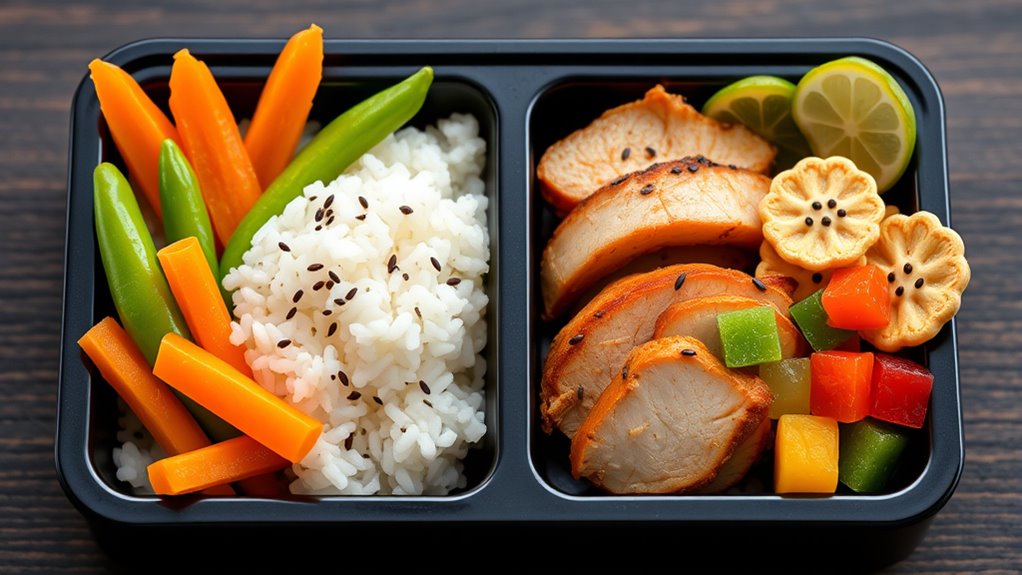A global bento box inspired by Japanese traditions offers a stylish way to pack balanced, colorful meals on the go. By choosing eco-friendly, reusable materials like bamboo or stainless steel, you help reduce waste. Use compartments to control portions and organize different food groups, making meals more appealing and nutritious. Thoughtful presentation and mindful packing support healthier habits and a sustainable lifestyle. Keep exploring to discover more tips for creating your perfect bento experience.
Key Takeaways
- Incorporate traditional Japanese elements like rice balls, pickles, and sashimi for authentic flavor.
- Use sustainable, eco-friendly materials such as bamboo or stainless steel for environmentally conscious packing.
- Design compartments to organize diverse food groups, emphasizing visual appeal and portion control.
- Pre-plan and prepare colorful, balanced ingredients to enhance meal presentation and nutritional value.
- Embrace cultural practices by reducing waste with reusable containers and utensils, promoting sustainability.

Packing a bento box lunch is a fun and practical way to enjoy a balanced meal on the go. It allows you to combine different food groups into a single, portable container, making mealtime both convenient and satisfying. When choosing your bento box, consider sustainable materials. Opt for eco-friendly options like bamboo, stainless steel, or reusable silicone containers. These materials reduce waste and are durable enough to withstand daily use. By selecting sustainable materials, you not only contribute to environmental conservation but also create a stylish, long-lasting lunch box that keeps your meals fresh and appealing.
Part of the appeal of a bento box is the ability to practice portion control. With separate compartments, you can easily manage the amount of each food type you include. This helps prevent overeating and encourages mindful eating habits. When preparing your meals, aim for balanced portions: a small serving of protein, a generous portion of vegetables, a moderate amount of carbs, and a little fruit or dessert. Using compartments ensures you don’t accidentally mix different foods, which helps maintain the integrity and flavor of each item. Plus, portion control makes it easier to track your intake and stay aligned with your nutritional goals.
Practice portion control with compartments for balanced, mindful meals.
To maximize the benefits of your bento box, plan ahead by pre-measuring ingredients into small containers or using reusable silicone cups for sauces and dips. This way, you can quickly assemble your meal each morning without hassle. Incorporate a variety of colorful vegetables, lean proteins, and whole grains to keep your lunch exciting and nutritious. Remember, the visual appeal of a well-organized bento can make eating healthier more enticing. When you pay attention to portion sizes and use sustainable containers, you’re supporting both your health and the planet.
Additionally, by choosing sustainable materials, you’re reducing reliance on single-use plastics, which are especially harmful to the environment. Reusable containers and utensils mean less waste in landfills and oceans. This eco-conscious approach aligns with the traditional Japanese philosophy of respecting nature and promoting harmony, which is often reflected in the artful arrangement of a bento. As you become more mindful of portion control and sustainable choices, you’ll find that packing and enjoying a bento lunch not only nurtures your body but also nurtures your commitment to a healthier planet. So, get creative with your ingredients, keep portions in check, and choose eco-friendly materials—you’ll enjoy a delicious, balanced meal while making a positive impact.
Frequently Asked Questions
What Are Eco-Friendly Materials for Bento Box Containers?
You should consider eco-friendly materials like biodegradable plastics and bamboo containers for your bento box. Biodegradable plastics break down naturally, reducing landfill waste, while bamboo containers are sustainable, lightweight, and durable. Both options help you minimize your environmental impact, making your lunch packing more eco-conscious. Choosing these materials supports eco-friendly practices and guarantees your bento box is both functional and environmentally responsible.
How to Prevent Food From Mixing in a Bento Box?
Did you know that using compartmentalized containers can reduce lunch waste by 20%? To prevent food from mixing, you should use these containers with separate sections. Layering techniques also help keep flavors distinct—place heavier or wetter foods at the bottom and lighter items on top. Make sure to seal each section tightly, and consider adding dividers if your container doesn’t have built-in compartments for extra separation.
Can Bento Boxes Be Used for Hot Meals?
Yes, you can use bento boxes for hot meals if they are microwave safe. Look for microwave-safe bento containers, which are designed to handle heat without damage. These hot meal containers let you reheat your food easily, making lunchtime more convenient. Just verify the bento box is labeled microwave safe, and avoid metal parts or non-microwave-safe plastics to prevent accidents or damage.
What Are Creative Ways to Pack Snacks in a Bento?
You can get creative with snack packing by using themed snack arrangements, like fruit animals or veggie flowers, to make your bento fun and appealing. Incorporate decorative food presentation, such as colorful dips or garnishes, to enhance visual interest. Use small compartments or silicone cups to keep snacks separate and organized. This approach not only makes snacks more enticing but also adds a personalized touch that elevates your bento experience.
How to Keep Bento Boxes Fresh During Long Outings?
To keep your bento boxes fresh during long outings, focus on food preservation and freshness tips. Pack items in airtight containers and add ice packs or frozen gel packs to maintain cool temperatures. Use moisture barriers like lettuce or parchment paper to prevent sogginess. Avoid packing perishable foods too early, and consider vacuum-sealing if possible. These steps help guarantee your snacks stay fresh and delicious until you’re ready to enjoy them.
Conclusion
Now that you know how to pack a bento box, imagine yourself savoring a colorful, balanced meal during your busy day. With just a little effort, you can turn an ordinary lunch into a delightful experience inspired by Japanese tradition. Why settle for boring sandwiches when a vibrant, neatly packed bento can brighten your mood and fuel your afternoon? Are you ready to elevate your lunch game and enjoy every bite?









